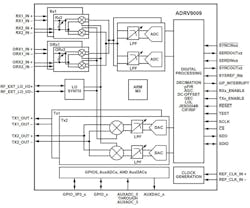New Semiconductors Meet the Challenge of Leading-Edge Radio Design
Download this article in PDF format.
Designing wireless equipment simply gets more complex each year. That statement is more accurate than ever as we enter the design phase for the forthcoming 5G equipment. 5G radio equipment must operate in the traditional cellular bands as well as other microwave and millimeter-wave bands, handle complex modulation schemes, demonstrate low power consumption, and implement new technologies like MIMO and antenna beamforming. A tough combination to achieve.
Nonetheless, those goals are being met as some semiconductor manufacturers have stepped up to make it easier to implement such advanced hardware. These new semiconductor devices are paving the path to 5G as well as meeting other demanding radio needs.
Sponsored Resources:
Applications
Probably the biggest challenge is implementing the next generation of cellular base stations that must cover the older 2G/3G/4G standards as well as those for 5G. Any new ICs addressing this need must also be able to support new features like massive-MIMO systems, active antennas, and point-to-point backhaul. Furthermore, these ICs must also help reduce chip count to minimize PCB space and reduce overall power consumption, plus significantly cut time-to-market.
Other than the cellular opportunities for advanced ICs, there are needs in the military/aerospace fields. Examples include defense communications systems, signals intelligence, electronic-warfare systems, and phased-array radars. New soldier battlefield radios can benefit from improved radio ICs, too. These new military radios will continue to operate half-duplex and use the push-to-talk (PTT) feature. Newer radios must also accommodate multiple waveforms, have lower power consumption, and the capability to handle data to deliver maps, images, and other graphics as well as voice.
Base-Station Design for 5G
The standard wide-area base station is one of the most demanding radio facilities to design. It must handle many users at the same time, cover a wide area reliably, and support multiple radio standards including 2G GSM, 3G, and 4G LTE. And, of course, the forthcoming 5G.
Potential customers are looking for 5G to enhance mobile broadband performance with higher speeds (1 Gb/s) and even greater capacity. Others are interested in low-latency machine connectivity to enhance industrial automation. The auto manufacturers are seeking the best technology for implementing its vehicle-to-everything (V2X) technology that promises fewer collision and deaths. The proposed C-V2X auto system would have the low latency and broad communications capability for vehicle-to-vehicle (V2V) systems in all future vehicles. The C-V2X offers a path to 5G.
A must-have feature for upcoming 5G base stations is the ability to implement multiple-input multiple-output (MIMO) technology. MIMO uses multiple antennas, each with its own transceiver, to transmit multiple data streams in the same bandwidth. This boosts spectral efficiency that delivers higher data rates and greater user capacity. Such a configuration has been difficult to implement up until now because the only practical way to make it work best is to put all of the radio circuitry inside the antenna. It not only makes the antenna larger, but also greatly increases power consumption and weight.
The main solution to weight reduction, size minimization, and lower power consumption is a higher level of circuit integration into smaller receiver and transceiver chips. In this way, the transceiver chips can be mounted on the antenna panel adjacent to its antenna element. This creates an antenna structure that can be the heart of new base-station designs. Smaller, lighter and lower-power MIMO with beamforming capability will also facilitate the deployment of small-cell base stations that will help enable 5G features and service over a wider coverage area.
The Secret Solution to the 5G Challenge
To make macro base stations 5G-compatible and meet the meet all of the challenges outlined earlier, Analog Devices has introduced a highly integrated CMOS transceiver and receiver, the ADRV9009 and ADRV9008, respectively.
The ADRV9009 is the widest bandwidth integrated transceiver that supports carrier-grade performance and fast frequency hopping, in addition to simplifying digital beamforming. The ADRV9008 integrates two high-performance receivers for base-station use or other demanding wireless applications. The transceiver can fully cover new base stations of 2G, 3G, 4G, and 5G with TDD access. And it fully supports MIMO and beamforming. The ability to adjust the local-oscillator (LO) frequency in each receiver or transceiver separately helps to enable phased-array beamforming techniques that minimize noise and improve dynamic range.
The ADRV9009 CMOS radio contains two transmitters and two receivers and just about everything else you need to build next-generation base stations and other advanced radios.
Some the core features of the ADRV9009 are dual transmitters and receivers, an operational frequency range of 75 MHz to 6 GHz, and fully integrated fractional N PLL synthesizers (see figure). Other features/specifications include:
- Multichip phase synchronization for RF LO baseband clocks
- 200-MHz receiver bandwidth
- Direct conversion zero-IF architecture
- On-chip ADCs and DACs
- High-speed JESD204B digital interface
- 1.3- to 1.8-V dc operational voltage is 1.3 to 1.8 V
- 12- × 12-mm, 196-ball, chip-scale BGA package.
The ADRV9008 dual direct-conversion receivers offer expanded dynamic range with manual or automatic attenuation control, dc offset correction, quadrature error correction, and digital filtering. Frequency coverage is the same at 75 MHz to 6 GHz.
The secret ingredient to the new chips is their exceptional receiver sensitivity. Combined with a low noise factor, the excellent sensitivity ensures the reception of signals farther away from the base station and improves the overall reliability of the connection.
If you’re designing new base stations, these devices are worth a look. Evaluation boards are available for design prototyping.
Sponsored Resources:
Related Resource:
About the Author

Lou Frenzel
Technical Contributing Editor
Lou Frenzel is a Contributing Technology Editor for Electronic Design Magazine where he writes articles and the blog Communique and other online material on the wireless, networking, and communications sectors. Lou interviews executives and engineers, attends conferences, and researches multiple areas. Lou has been writing in some capacity for ED since 2000.
Lou has 25+ years experience in the electronics industry as an engineer and manager. He has held VP level positions with Heathkit, McGraw Hill, and has 9 years of college teaching experience. Lou holds a bachelor’s degree from the University of Houston and a master’s degree from the University of Maryland. He is author of 28 books on computer and electronic subjects and lives in Bulverde, TX with his wife Joan. His website is www.loufrenzel.com.

